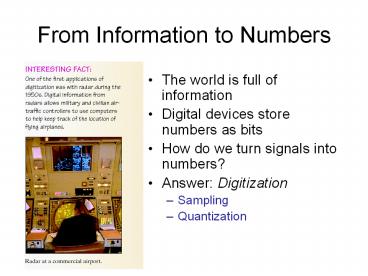From Information to Numbers PowerPoint PPT Presentation
1 / 50
Title: From Information to Numbers
1
From Information to Numbers
- The world is full of information
- Digital devices store numbers as bits
- How do we turn signals into numbers?
- Answer Digitization
- Sampling
- Quantization
2
Sampling
- Sampling Taking signal values at
regularly-spaced intervals - Formula
- sn s(nTs)
- s(t) original signal
- sn sampled signal
- Ts sampling period
- fs 1/Ts is the sampling rate.
3
(No Transcript)
4
(No Transcript)
5
Sampling Involves a Tradeoff
- Too small a Ts makes too many samples
- Too large a Ts ruins the sampled signal
- How do we design Ts?
- Answer The Nyquist Rate
6
The Nyquist Rate
- We already know Any signal can be made from a
sum of sinusoids. - Suppose that a particular signal is made up of
sinusoids whose frequencies are between fhighest
and flowest. - (fhighest - flowest) is called the bandwidth.
- This signal can be exactly reconstructed from its
samples if fs gt 2 (fhighest). - The value of 2 (fhighest) is called the
Nyquist Rate.
7
Sampling Above and Below the Nyquist Rate
- fs gt 2 (fhighest - flowest)
- fs lt 2 (fhighest - flowest)
8
Sampling Rates for Some Important Signals
- Designers use these sampling rates to design CD
players, DVD players, cell phones, car radios,
and satellite TV.
9
(No Transcript)
10
(No Transcript)
11
(No Transcript)
12
(No Transcript)
13
(No Transcript)
14
(No Transcript)
15
(No Transcript)
16
(No Transcript)
17
(No Transcript)
18
(No Transcript)
19
(No Transcript)
20
(No Transcript)
21
(No Transcript)
22
(No Transcript)
23
(No Transcript)
24
(No Transcript)
25
(No Transcript)
26
(No Transcript)
27
(No Transcript)
28
(No Transcript)
29
(No Transcript)
30
(No Transcript)
31
(No Transcript)
32
(No Transcript)
33
(No Transcript)
34
(No Transcript)
35
(No Transcript)
36
(No Transcript)
37
(No Transcript)
38
(No Transcript)
39
(No Transcript)
40
(No Transcript)
41
Sampling Below Nyquist Causes Aliasing
- Example A 720Hz sinusoid sampled at a rate of
660Hz
looks like a 60Hz sinusoid!
- Filters are used before sampling to prevent this.
42
Representing Text in Binary ASCII
- ASCII American Standard Code for Information
Interchange - A 7-bit code (8-bit representation) to represent
128 symbols - Capital and small letters (a-z, A-Z)
- Numbers (0-9)
- Punctuation (e.g. !_at_()_)
- Other control codes (line feed, end of file)
Why would a standard code be so important?
43
Partial ASCII Code Listing
What is 1001001 1001110 1000110
1001001 1001110 1001001 1010100 1011001 ?
Answer INFINITY
44
Storing Samples Using Bits Quantization
- Digital devices must use a limited number of bits
to store each sample of a signal. - The errors caused by quantization are seen and
heard as noise.
45
More Bits Mean Smaller Errors
- Example
- Top 3 bits per sample
- Middle 4 bits per sample
- Bottom 16 bits per sample
- More bits mean higher accuracy, but more storage
and effort
46
How Many Bits Per Sample?
- We would like a measure of signal quality as a
function of number of bits - The answer Signal-to-Noise Ratio
- Used in almost every multimedia system design
- Definition (linear scale) SNR
max(ltsignalgt) - max(ltnoisegt)
- Definition (dB scale) SNR in dB 20
log10 max(ltsignalgt) - max(ltnoisegt)
47
Decibel Scale
- Named after Alexander Graham Bell, inventor of
the telephone - Convenient for very large and vary small SNRs
48
Problem SNR
- What is the SNR for the signals on the left?
- What is the SNR in dB?
- Answer 0.8/0.06 13.3
- 20log10(80/0.6)22.5dB
49
Example Problem SNR
Fact SNR can be used to measure the quality of
many signals
50
SNR for Quantized Signals
- For a B-bit quantized signal
- SNR (2B-1)/2-1 2B
- Simple dB Rule SNR 20 log10(2B) 6.02 B
- Each bit adds 6 dB to the SNR
- Example CDs use 16 bits
- SNRCD 96 dB

